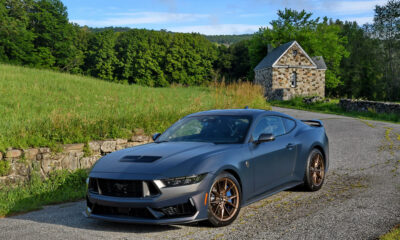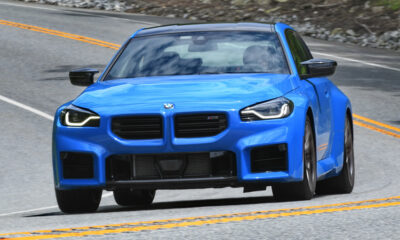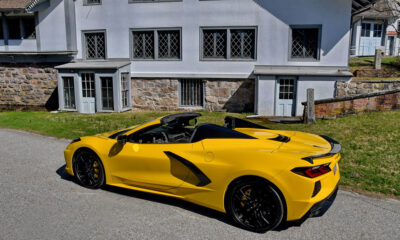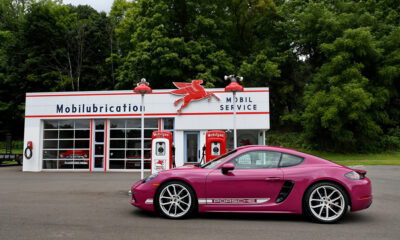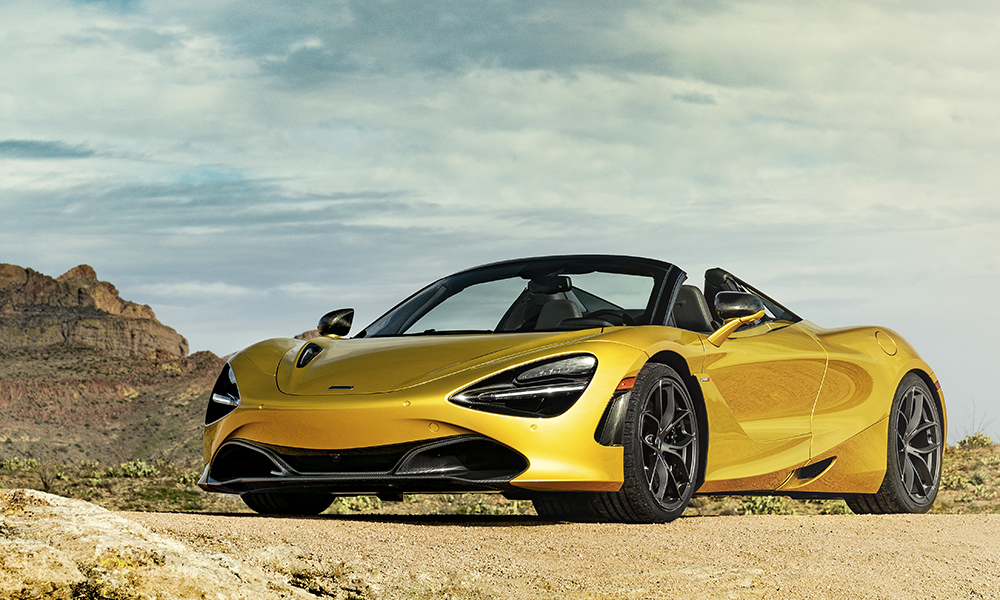
Photo: McLaren
Since launching in 2010, McLaren Automotive hasn’t stopped jostling for a place at the supercar high table next to the likes of Ferrari and Lamborghini.
Jump-started by a motorsport heritage, the British manufacturer has defied its relative youth by producing everything across the top-end market from accessible sports roadsters to track-focused monsters in a tiny timeframe.
Woking has been breathless in shifting out cars at a rate of more than one new coupe a year to pad out its Sports, Super and Ultimate Series ranges.
This vigorous growth might lull you into the impression that the designers are rushing their supercar production, but the releases have been consistently extraordinary, and continue with the new ‘Super Series’ 720S Spider.
Packed full of changes from its closed-cockpit derivative, mostly to make way for a gorgeous folding roof, it still manages to keep all the bite of the iconic coupe.
If Ferrari’s 488 is the prancing horse, and Lamborghini’s Huracan is the raging bull, then the 720S must surely be the velociraptor of the supercar world.
The convertible edition of 2017’s broadly-acclaimed 720S Coupe, which is the basis for McLaren next GT3 racer, is a sharp, featherweight machine with the looks to match its predatory attributes.
It’s fitting, then, that Arizona – a place known for its dinosaur fossil discoveries – should be chosen as the launch site for the company’s most rounded spider model to date.
Despite taking only five years to launch, race and replace the entire 650S range with the 720, it doesn’t feel like McLaren has rushed anything here with the final installment of this second-gen supercar.
The result, pleasingly, is a spider that can cruise around serenely but still exhibit the same crunching performance numbers as the coupe when called upon.
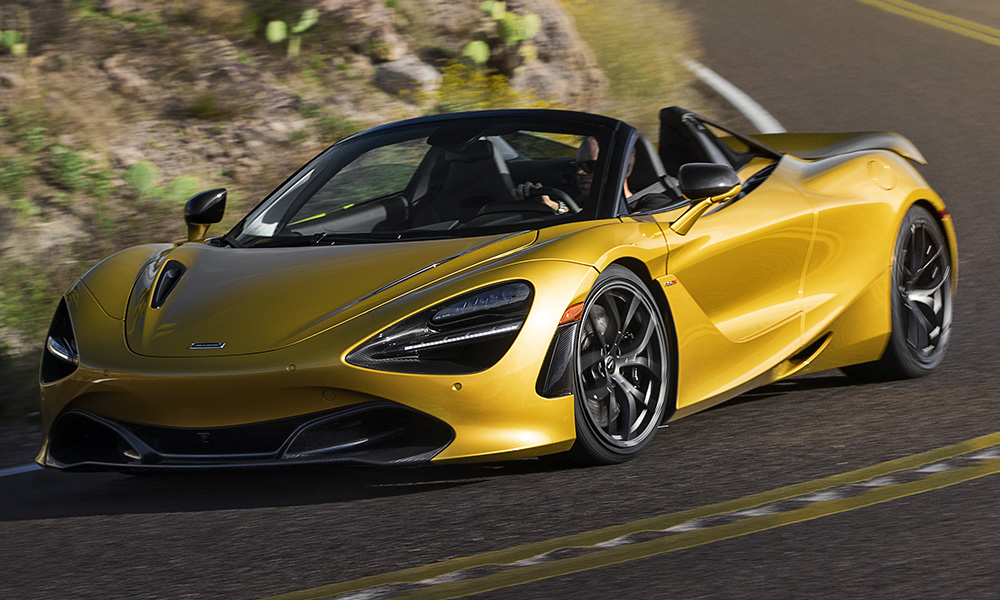
Photo: McLaren
The deserted lanes radiating out from Phoenix, America’s fifth largest city, provide a natural habitat in which to test the Spider’s new features and marvel in the known strengths of the 720S baseline.
On the open highway, its smoothness was a tease, but things shifted immensely when we took it on a more spirited blast down a stunning lane to the Bob Ross-esque Bartlett Reservoir.
When asking a little more of the 4.0-liter V8 engine, the bespoke Pirelli P Zero tires came alive and accepted even the most rigorous of cornering methods.
Of course, there is always some intrinsic frustration that comes with piloting a supercar as powerful as this when you consider only a fraction of its full potential can be realized on the road.
But you can still shock yourself at the 2.8 seconds it takes for the 720S to shoot from 0-60 mph – just about the fastest off-the-line experience in the market.
With that kind of crisp power surge, it’s clear to see why supercar drivers really don’t mind being held up by a red light – especially when there’s a teasing stretch of barren Arizona tarmac ahead.
McLaren says you can then top out in the open-top at a savage 202 mph – if you’re brave enough – or 212 with the roof up. That’s crazy fast.
At more sensible speeds, the visibility afforded by the panoramic windshield is mesmerizing, especially when combined with the gorgeous, constantly evolving backdrop of mountains encircling Phoenix.
This mobile vista was exaggerated after packing down the roof in a paltry 11 seconds – three less than the Ferrari 488 Spider and six less than the convertible Lamborghini Huracan, which has the same fold time as the 650S.
McLaren also continues to comfortably lead its self-ascribed ‘weight race’, with the Spider’s lightest dry figure of 1,332kg, undercutting the 488 by 100 kilos and the Huracan by 200.
And while the 720S Spider is just under 50 kg (around 4 percent) heavier than the coupe, the cars are matched in off-the-line speed up to the best part of 130 mph.
In a game of cutting the losses, McLaren has thinned the technical divide between coupe and spider to a trace.

Photo: McLaren
The electronic folding roof is the 720S Spider’s literal crowning glory.
Not just content with shearing the top off, McLaren has managed to design a feature that gels perfectly into the aerodynamic flows of the 720’s teardrop bodywork.
The buttresses supporting the roof are innovative for their glass construction, creating unobstructed views out the back of the car.
Andrew Kay was the lead designer of both 720S variants and explained to Sportscar365 how McLaren planned the Spider’s roof to operate with such deft synchronicity.
“Our previous roof system was a two-panel roof,” he said.
“There’s a mechanism that runs all the way along the cant rail inside of the roof in order to fold it in half, [but] that mechanism would have been brought into the driver’s head if we had moved that system in 50mm.
“So that meant that the only way we could make the car have 700-horsepower was to make a new roof system.
“It was literally day one, meeting one, that we decided we need to have a new single-piece roof system that moves very simply forward and backward on a four-bar linkage.”
The roof is one of the finest examples of convertible supercar tech out there.
However, the openness it provides doesn’t make the cockpit feel any larger for occupants of a taller disposition.
Despite being longer than its 650S predecessor, the 720S will demand a lot from people over six foot to get comfy in the utilitarian cockpit.
This is to be expected, though, from a manufacturer so deeply-rooted in carbon fiber theory: the snug-seeking spider market is far removed from McLaren’s founding ethos of lighter, smarter and faster.
Another interior snag is the awkwardness involved in reaching behind the central panel ‘bridge’ into the drinks tray behind.
For this, the 600LT Spider’s ‘halfway house’ approach of splitting the central panel removes any obstruction and is, therefore, better for longer trips.
We still managed to get a good couple of hours behind the wheel, though, spurred on by the immense and addictive power this car produces.

Photo: MPS Agency
“Fantastic Platform” for GT3
The 720S Spider neatly coincides with the next step in McLaren’s racing endeavors with the GT3 version of the coupe model.
While McLaren eventually hand-picked the 720S line for its third-generation GT3 after MP4-12C and 650S, the road car wasn’t designed with racing in mind.
But it naturally lends itself to the track and all the traits required to compete in the world’s toughest endurance races are observable in the civilian version.
Besides the eye-widening acceleration and telepathic handling, the headlights are searchingly bright because of how they fit into the car’s raptor-like frontage.
“By not having a very sloped lens on the headlamp, our lights are 30 percent brighter as a result,” said Kay of the 720’s dental glow.
“It was a difficult thing to design because it’s so architectural. Particularly the carbon fibre version of the ducting that goes in there – I genuinely don’t know how the guys make that.
“It’s an extraordinary shape and really technically demanding. But it’s worth it, because it’s such a defining feature of the car.”
This design works from a brand perspective, too.
The 720S is, if you exclude the haywire hypercars of Senna and Speedtail, McLaren’s most visually distinctive model because of those reptilian eye sockets that set it apart from the smoother-faced 500 and 600 models – and even the P1.
That’s crucial because the GT3 version will be representing McLaren around the world this year, with race programs confirmed in Super GT, British GT, the IMSA WeatherTech SportsCar Championship and elsewhere.
“My department within McLaren is blessed by the base product that we’re gifted by the main business,” said McLaren Automotive director of motorsport Dan Walmsley.
“If you look at the core principles of what a race car needs to be, it’s torsional stiffness, low center of gravity, good base aerodynamics, weight distribution etc.
“The 720 road car is a fantastic platform for that.”
Walmsley explained how the racing 720 is “95 percent different” to the road model and that its specific aero design was the hardest element to adapt.
“The bodywork was probably the one that we underestimated,” he said.
“The airflow through the 720S road car is very well engineered, and we had to replicate that with an entirely different surface of the car, which has grown in many areas, whether that’s dimensionally or to accommodate the new slick tires.
“It has to retain the aesthetics of what a 720S road car looks like, not just for FIA homologation purposes but also for brand and marketing purposes. It has to look like a McLaren.”

Photo: McLaren
While there are comfier and cheaper convertibles out there, McLaren’s $315,000 (£237,000) 720S Spider is still a prize pick because of its crushing performance attributes.
Here, McLaren can boast a car that puts up better numbers than the original Ferrari 488 and Lamborghini Huracan spiders, and even tops the Italians’ beefed-up Pista and Performante versions on most counts too.
The coupe was a fierce, voracious machine and it was a huge task for the company to ‘spiderfy’ something so taught and precise without losing the insanity that made the coupe so great.
But it managed the task, and the 720S Spider can now stand proud as just about the most extreme convertible supercar out there.
It now begs the question of how much further McLaren can go with its future open-toppers.
Whatever it comes up with next will require a huge response from the wary engineers at Sant’Agata and Maranello.

Photo: McLaren

















